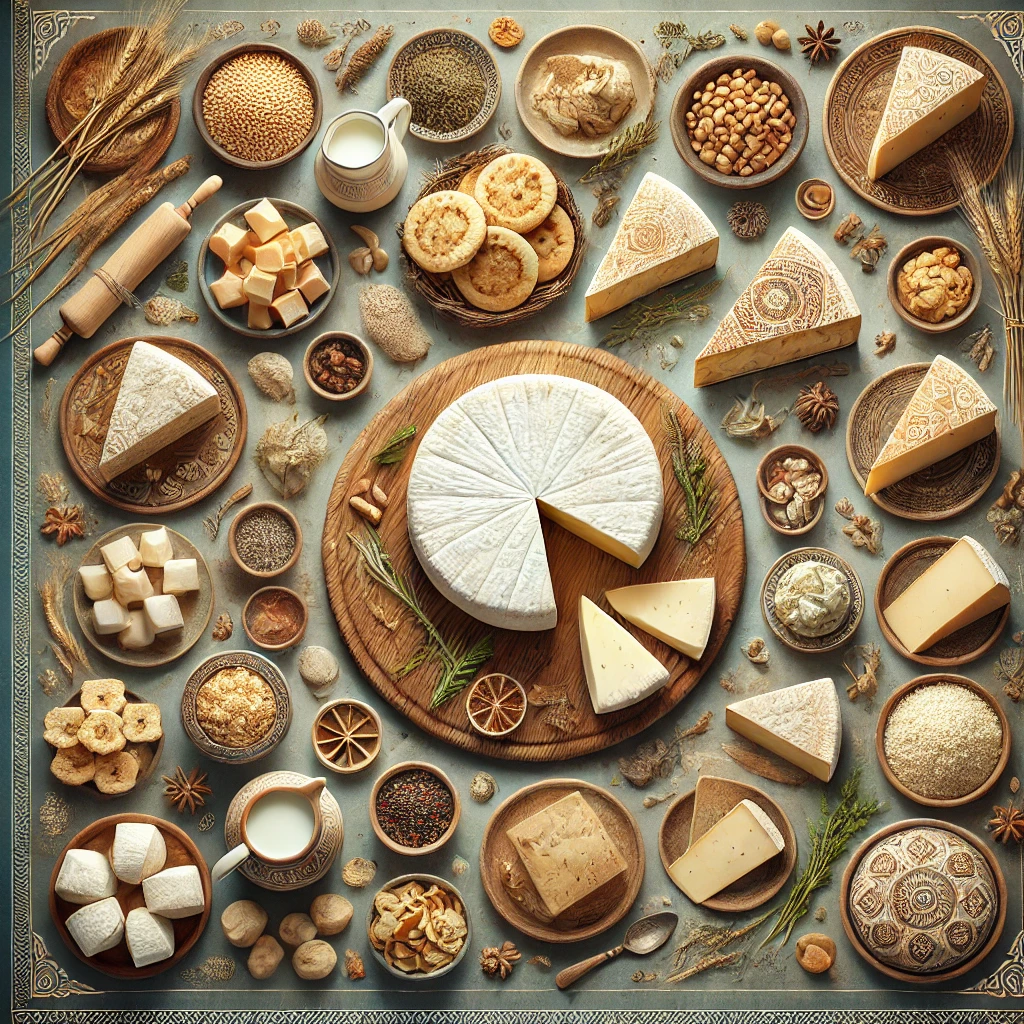Kazakhstan is celebrated for horse culture, nomadic history, and vast steppes that stretch beyond the horizon. Yet one of its most fascinating culinary traditions is not only kumis (fermented mare’s milk) but its deep dairy craftsmanship, including the lesser-known but culturally important Sarysu cheese. Named after the Sarysu region—an area defined by open grazing lands, pastoral life, and Turkic heritage—this cheese reflects Kazakh practicality, climate adaptation, and identity.
Sarysu cheese is a product of land, migration, and necessity. Produced in a region where herding remains central, the cheese embodies ancient nomadic food preservation techniques. It is robust yet nuanced, firm yet flavorful, brined yet wholesome. More than food, it is an archive of how Kazakh shepherds transformed raw milk into a travel-proof, energy-rich, and seasonally dependable staple.
🧀 What Is Sarysu Cheese?
Sarysu cheese is a semi-hard, brined, and salt-forward dairy cheese typically made from cow’s milk or a cow-sheep blend, occasionally influenced by goat milk in smaller rural households.
Key Characteristics
| Feature | Description |
|---|---|
| Texture | semi-hard, slightly crumbly, brined |
| Flavor | salty, tangy, grassy, clean finish |
| Salt Level | medium to high |
| Color | pale white to ivory |
| Milk Source | cow or sheep (sometimes mixed) |
| Preservation | brine-based, long shelf life |
| Aroma | fresh dairy with mild fermentation |
Its brine bath ensures preservation across long winters, drought periods, and nomadic movement across the Kazakh steppe.
🌍 Regional & Cultural Roots
Sarysu cheese emerges from a nomadic dairy worldview. Kazakh food culture evolved around mobility, livestock, weather extremes, and self-sufficiency. Herds traveled, milk flowed, and cheese became both sustenance and survival.
Why Sarysu Cheese Matters
-
reflects centuries of pastoral life
-
essential to travel-friendly nutrition
-
community sharing tied to seasonal pasture cycles
-
preservation technique rooted in survival
Kazakh dairy consumption is not merely culinary—it is cultural continuity passed from herder to herder.
🐄 How Sarysu Cheese Is Made
Traditional cheese making in the Sarysu region follows natural rhythms rather than industrial timers.
Production Process
-
Morning milk collection from grazing cattle
-
Natural curd formation using rennet or soured whey
-
Draining in cloth sacks to remove whey slowly
-
Pressing into firm blocks or wheels
-
Heavy salt rub to create brine readiness
-
Submersion in brine (water + salt) for days or weeks
-
Optional short aging in cool storerooms
Unlike European rinds, Sarysu cheese does not develop mold crust. Instead, its flavor evolves inside the brine, creating a cheese that is mineral-salty and age-resistant.
Why Brining Is Essential
-
prevents spoilage in the hot Kazakh summer
-
supports nomadic storage without refrigeration
-
adds protein density and harsh-winter endurance
Milk in the steppes is nourishment, but brined cheese becomes nutrition that waits for you.
🍽 Taste & Texture: Simple, Strong & Steppe-Driven
Flavor Notes
-
prominent salt
-
clean dairy profile
-
slight tang from fermentation
-
grass-fed undertones (steppe grazing)
-
crisp mineral finish
Texture Notes
-
firm, sliceable
-
slightly crumbly
-
smooth white center
-
not melty, not stretchy
Sarysu cheese is closer to feta-meets-sirene but more austere, dry-edged, and salt-resilient.
🌍 International Comparisons
| Cheese | Similarity | Difference |
|---|---|---|
| Feta (Greece) | brined, tangy | feta is creamier, softer |
| Sirene (Bulgaria) | similar salt & firmness | Sarysu is drier & less acidic |
| Halloumi (Cyprus) | firm body | Sarysu cannot fry or grill elastically |
| Queso Blanco (Latin America) | crumbly texture | not brined, less salty |
Sarysu’s identity lies in Kazakh brine tradition, not Middle Eastern elasticity or Balkan tang.
🍴 Culinary Uses in Kazakh Cuisine
Traditional Pairings
| Dish | Pairing Purpose |
|---|---|
| flatbread (nan) | balances salt with grain warmth |
| dried meat (kazy or shuzhyk) | salt-on-smoke harmony |
| fermented mare’s milk (kumis) | tang meets tang |
| tea with milk | dairy comfort balance |
Cheese is rarely eaten plain. It partners with bread, tea, or cured horse sausage to form a full meal.
🌿 Modern Culinary Applications
-
grated over roasted potatoes
-
cubed in tomato-cucumber salads
-
crumbled on pilaf dishes
-
added to savory pastries
-
used in cheese dips with dill & garlic
Kazakhstan’s chef movement is now elevating rural cheeses with contemporary plating and herb accents.
🥘 Best Flavor Pairings
| Ingredient | Why It Works |
|---|---|
| dill | classic Central Asian herb contrast |
| sour cream (smetana) | softens salt intensity |
| cucumbers | cooling effect against brine |
| fermented cabbage | tang vs salt balance |
| honey | sweet-salty delight |
A drizzle of Kazakh wild honey on Sarysu cheese reveals a deeper softness beneath its salt armor.
🍷 Beverage Pairing
Traditional Kazakh meals avoid alcohol pairings, but modern settings allow comparison.
Traditional
-
kumis (fermented mare’s milk)
-
shubat (fermented camel milk)
-
strong black tea
-
tea with cream
Contemporary
| Drink | Why It Works |
|---|---|
| dry rosé | cuts saltiness cleanly |
| citrus-infused sparkling water | refresh palate |
| unfiltered cider | rustic harmony |
| wheat beer | soft grain contrast |
🧂 Storage & Climate Adaptation
Sarysu cheese is a heat-designed product. Brine protects flavor, form, and safety.
How to Store
-
always in brine
-
refrigerated if available
-
airtight glass or ceramic
-
avoid plastic (flavor transfers)
Shelf Life
-
4 to 6 weeks in strong brine
-
salt concentration improves longevity
Salt Reduction Tip
-
soak cheese blocks in water 10–20 minutes before serving to soften salt tone
⭐ Final Summary
Sarysu cheese is a dairy emblem of Kazakhstan’s steppe history—firm, brined, and created for endurance rather than indulgence. It reflects:
-
nomadic practical wisdom
-
survival without refrigeration
-
culinary simplicity aligned to livestock cycles
-
salt-based preservation that enabled migration
With its quiet strength and brined clarity, Sarysu stands apart from milder global cheeses. It does not melt for pizza or stretch on a grill. Instead, it preserves pastoral memory in every crumbled slice served with tea and bread beneath wide Kazakh skies.
FAQs — Sarysu Cheese
1. What milk is used in Sarysu cheese?
Primarily cow milk, sometimes blended with sheep milk.
2. Is Sarysu cheese salty?
Yes—brine-based preservation gives it a medium to high salt profile.
3. Can it melt like cheddar or mozzarella?
No—it softens but does not stretch or melt.
4. How long does Sarysu cheese last?
Up to 4–6 weeks in strong brine.
5. How is it traditionally eaten?
With flatbread, tea, cured meats, and sometimes fermented dairy drinks.



